Among the five iconic national parks in Utah, often referred to as the Mighty Five, Arches National Park may be the most recognizable.
From Delicate Arch’s feature on the Utah state license plate to influencer snaps of natural arches across social media, most people need no convincing to visit Arches National Park once they know what it is.
In the summertime, the park is bustling with visitors, sweaty and eager to see all the top attractions in the park, and the roads can be clogged up with people trying to fit in all the hotspots on their Arches itinerary.
| ⌛ Planning your wintery Arches trip in a hurry? Here are my quick picks. ❄️ Best Arches Tours & Experiences 1. Half Day 4×4 Tour of Arches National Park 2. Full Day 4×4 Tour of Arches & Canyonlands National Park 3. Arches 4×4 Tour & Hiking Experience 🛏️ Best Arches NP Area Hotels 1. Red Cliffs Lodge (comfortable lodge at mid-range prices) 2. Under Canvas Moab (gorgeous glamping with wood stoves for heat) 3. Element Moab (budget-friendly, spacious rooms) Arriving in Utah by plane and driving to Arches? → Book your rental car here! |
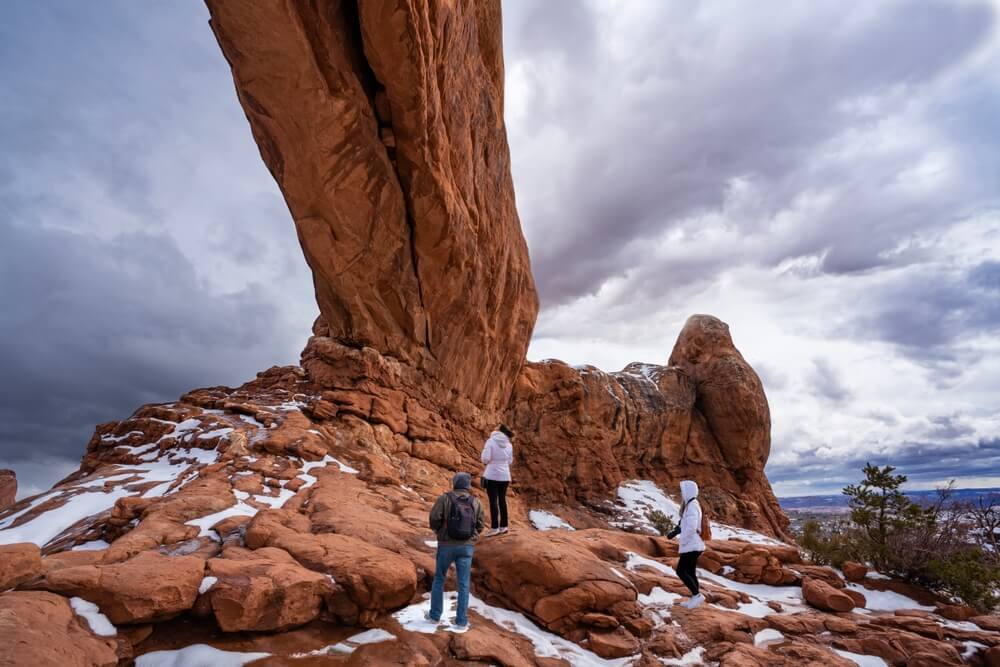
On the other hand, winter is a much more serene season in Arches.
In addition to its quieter crowds, its natural beauty is emphasized when the occasional dusting of fresh snowfall creates a stark white contrast to the naturally-red canyon walls and natural arches.
Although daily visitors tend to drop correspondingly with the lowering temperatures, there’s still a ton to do in Arches National Park in winter!
Table of Contents
Things to Do in Arches National Park in Winter
Take a scenic drive through the park.
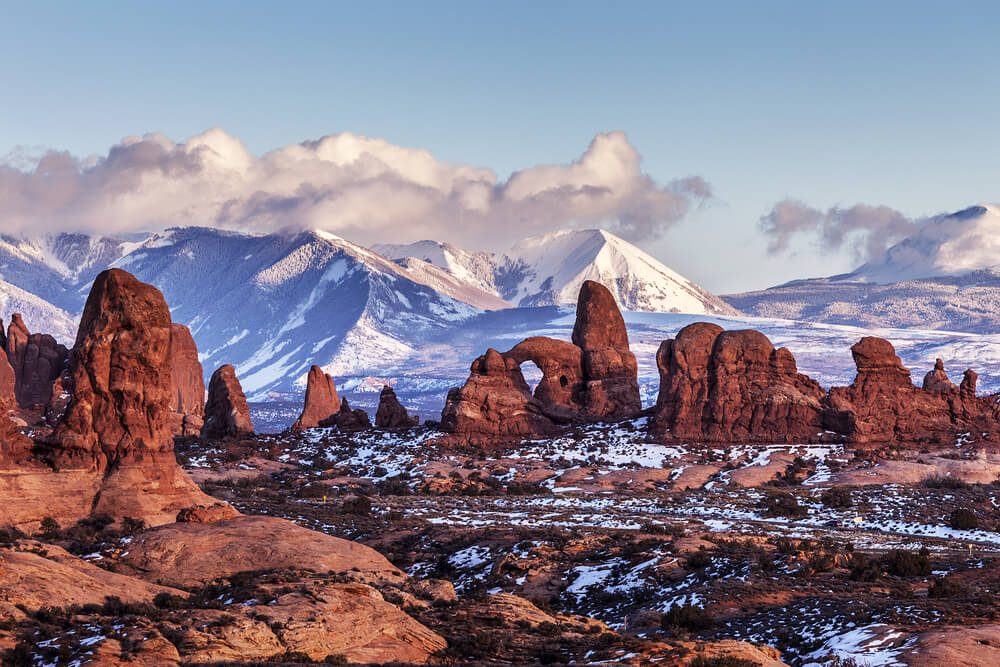
Embark on a picturesque journey through Arches National Park by car, meandering through its striking red rock formations.
Luckily for those who want to avoid the winter cold as much as possible, many of the park’s iconic attractions can be admired right from the comfort of your car.
For those colder winter days, taking the scenic drive of Arches in winter outlined below offers a cozy way to explore.
Crank up the car heater and enjoy a warm Thermos of hot chocolate!
Start your journey from the park’s main entrance, with a brief pit stop at the visitor center to get oriented, before you make your way through the main scenic route.
If you can allocate about 5 hours, you’ll have ample time to navigate all the paved routes within the park, allotting a leisurely 10-15 minutes at each viewpoint.
As you cruise through the captivating landscape of Arches National Park, make sure to take detours to The Windows Section, Wolfe Ranch, and the Delicate Arch Viewpoint.
These spots are undoubtedly among the park’s prime attractions accessible by car.
Hike to the scenic Delicate Arch.
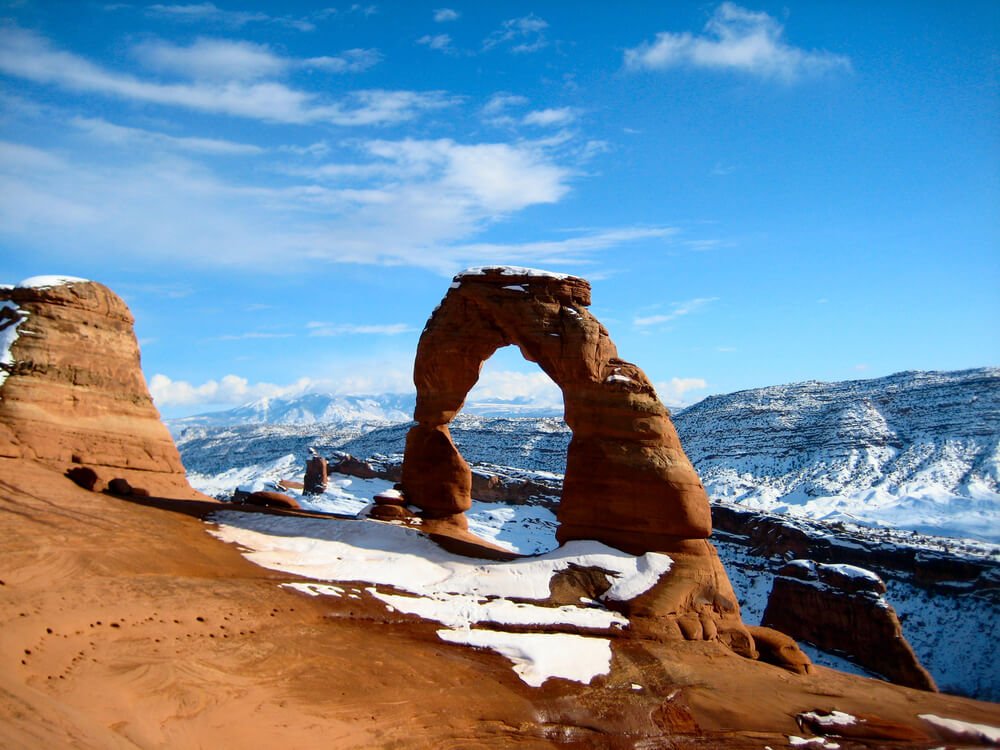
If you were to have to make the difficult decision of just one winter hike in your visit to Arches National Park, the Delicate Arch Trail should be at the top of your list!
The 3-mile roundtrip journey brings you up close and personal with the larger-than-life.
It takes approximately 2-3 hours, varying with conditions — owing to the trail’s terrain icy patches are common.
It’s wise to pack some crampons for icy terrains, though refrain from using them on exposed sandstone since that can damage the landscape.
What makes this the premier winter hike in the park? Isn’t it obvious?
It’s all about the awe-inspiring backdrop of the snow-clad La Sal Mountains behind Delicate Arch, an icon of the park: a truly unparalleled panorama.
Take a hike to Landscape Arch.
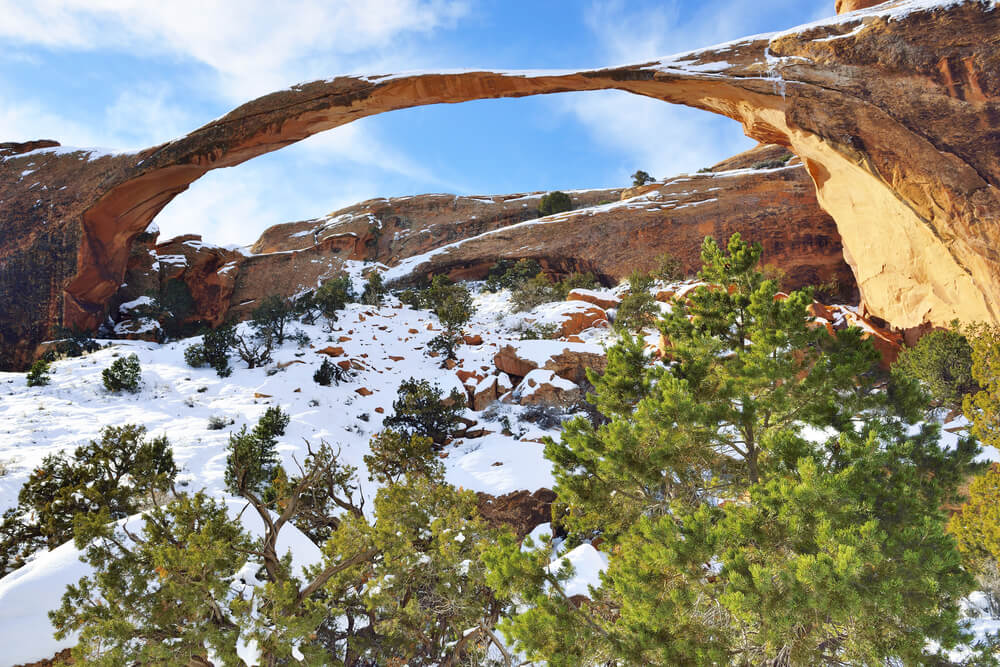
In winter and summer alike, Devil’s Garden stands out as a favorite hiking spot in Arches National Park.
In winter, it’s a good choice due to its relatively smooth trails and a series of magnificent arches.
Two primary trails beckon: one leading to Landscape Arch and another to Double O Arch (detailed below).
Landscape Arch, a marvel within the Devil’s Garden, boasts the title of North America’s longest arch, spanning an impressive 306 feet!
Although a section of the arch fell in the 1990s, it still stands as a complete arch — at its thinnest, it measures a mere 6 feet across.
The 2-mile roundtrip to the Landscape Arch serves as a fantastic midpoint for those who don’t want too much of a challenge.
Make the longer trek out to Double O Arch.
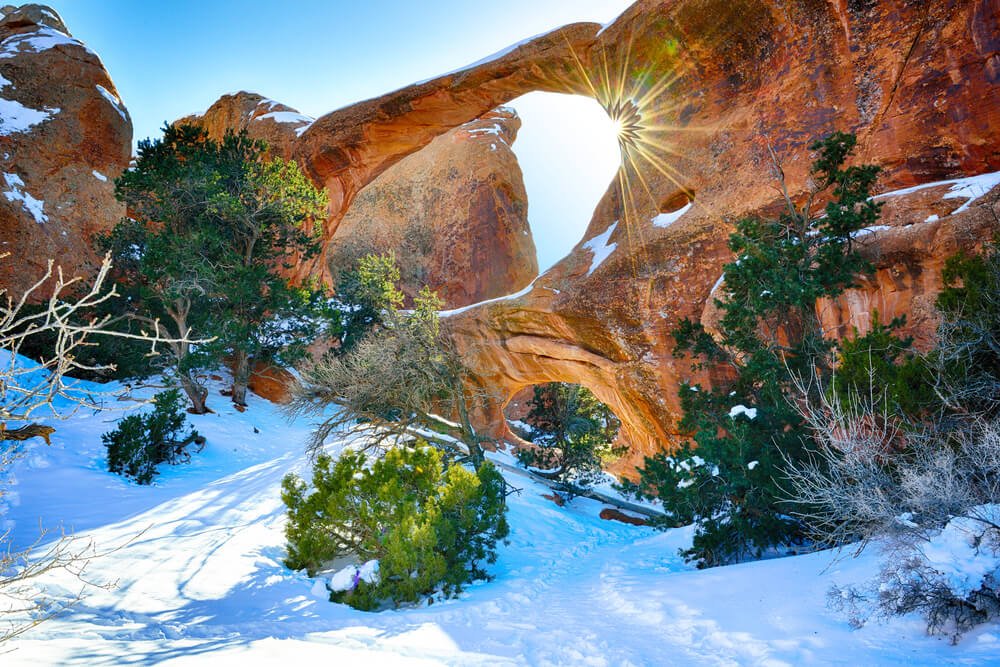
For those seeking an added dash of challenge, extending the hike to Double O Arch is a must, but be careful in snowy conditions.
The trail’s terrain is uneven, and certain stretches have narrow pathways flanked by steep drop-offs.
In snowy and icy conditions, this hike should be reserved for the adept winter hiker!
Spanning just over 4 miles roundtrip, the journey to Double O Arch is demanding but promises unmatched rewards, even with winter’s added challenges.
Enjoy some winter photography.
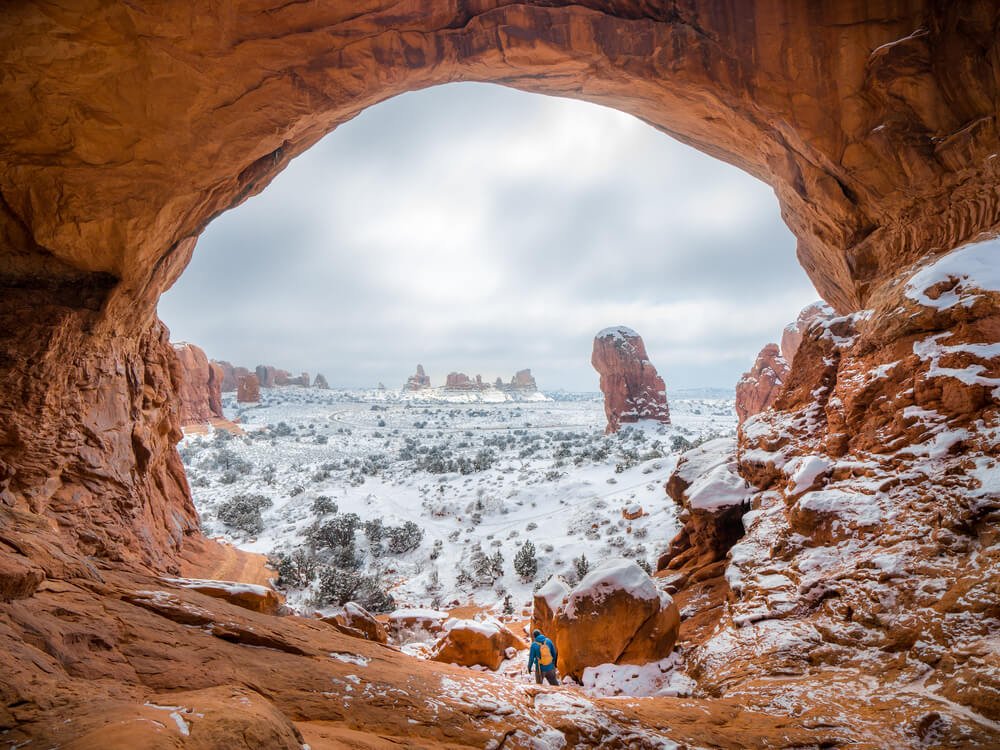
If you are lucky enough to visit Arches National Park soon after a fresh snowfall, you simply must explore the park with a camera in hand!
The fresh powdery snow lining the red rock features and magnificent natural arches is something that very few people are lucky enough to see in person.
Although Arches National Park does typically receive a half-foot of snow each year, it melts quickly once met by sunshine.
Some of the best places to explore for winter landscape photography are The Windows Section and Devils Garden.
Both of these areas offer maintained hiking trails and opportunities to photograph snowy arches.
Take a 4×4 tour of Arches (and maybe Canyonlands!)
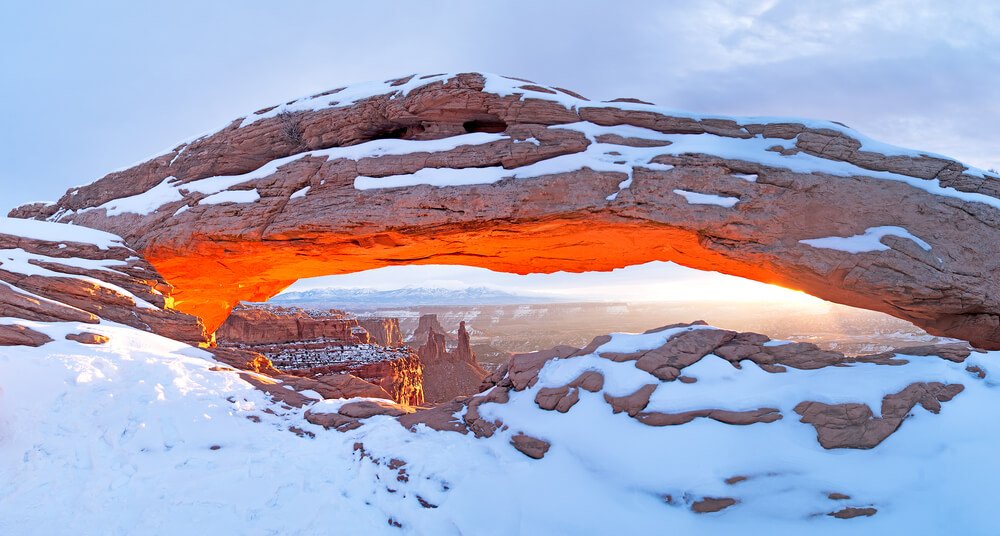
If you’d like to take a break from winter hiking in Arches National Park, another great way to see the epic Utah winter landscape is by 4×4 tour!
You can take a half-day 4×4 tour leaving from Moab, which will tour Arches off-road.
On this half-day tour, you’ll get to see several spots that regular visitors by car just can’t get to, including Tower Arch, Eye of the Whale Arch, the Marching Men, and more.
Alternately, you can opt for a full-day 4×4 tour that encompasses both Arches and Canyonlands, ticking two Utah National Parks off your bucket list with one off-roading adventure.
In addition to seeing Arches, you’ll also get to explore the massive Canyonlands park.
This full-day Arches and Canyonlands tour covers the Island in the Sky part of the park, one of the more accessible parts of the park.
It also includes driving along Shafer Trail, seeing Tower Arch, and getting to check out ancient fossilized dinosaur tracks!
Marvel at Dead Horse Point State Park
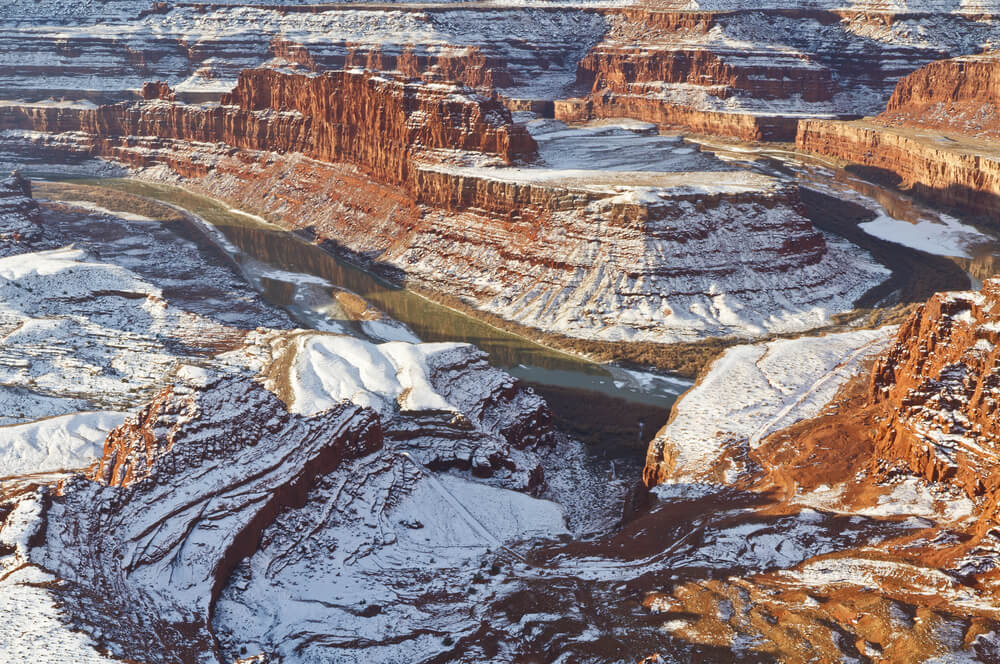
While this guide covers traveling to Arches National Park in winter, one of the best things of basing your winter itinerary in Moab is just how close it is to several incredible national parks and state parks.
Head outside the park for a half-day trip to Dead Horse Point State Park, which is one of the most beautiful places to visit in Utah.
It’s even more spectacular in the winter if you’ve been lucky enough to get a bit of snow!
Where to Stay Near Arches
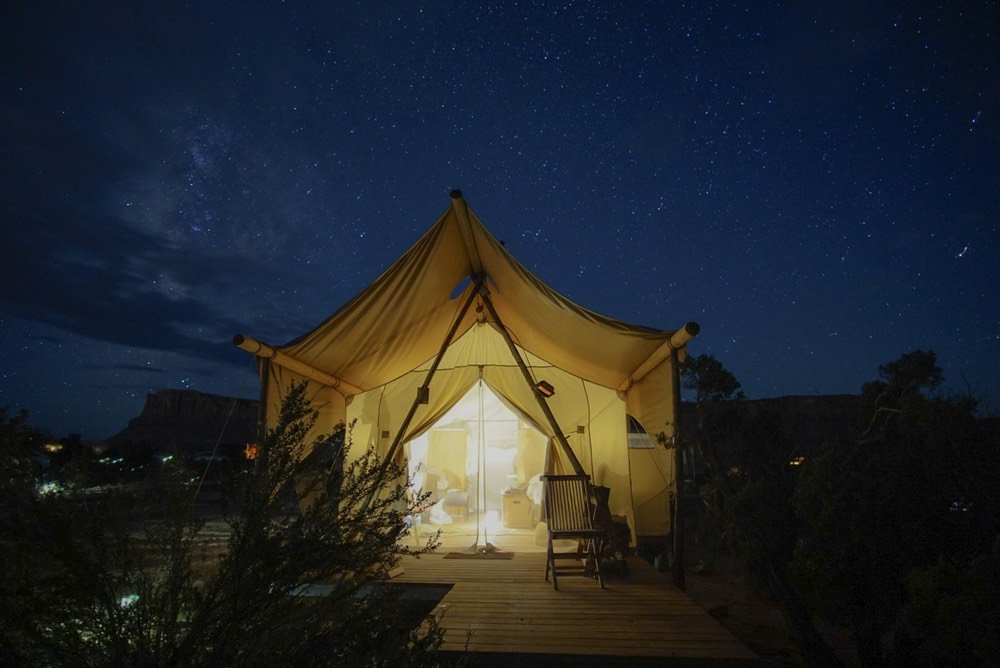
Winter Glamping: Moab Under Canvas
I finally got to stay at Moab Under Canvas on my last trip to Moab and it did not disappoint!
The tents were laid out so thoughtfully and I loved the amenities like the in-tent bathrooms, including hot showers!
There was also a wood stove in the tent which would have made it great for chilly nights, too (I visited in the summer, but it looks well-appointed for winter visitors, too!)
Mid-Range Comfort: Red Cliffs Lodge
Located right on the Colorado River, this gem is a bit outside of Downtown Moab and Main Street but it’s worth the small sacrifice of convenience for a location this spectacular.
There’s an on-site pool, hot tub, fitness area, and restaurant, and there are also activities available such as wine tasting and horseback riding that the property can organize.
Budget Stay: Element Moab
Lots of hotels in Moab can be on the pricy side, but this comfortable, large hotel is one of the better-priced options in the region.
The rooms are huge and spacious, especially for the price you pay!
Winter Weather in Arches National Park

Arches National Park in winter is generally pleasant and not too cold, with periodic (though not guaranteed!) snow.
While Arches isn’t extremely cold in the winter, it is at a relatively high elevation.
The lowest elevation part of the park is 4,085 feet at the Visitor Center; the highest elevation is at 5,653 feet.
Due to that, Arches experiences more snowfall than lower-elevation parks at a similar latitude.
The table below shows average temperatures in Arches National Park during the winter:
| Month | High Temperature | Low Temperature |
| December | 41° F | 20 °F |
| January | 40° F | 18° F |
| February | 49° F | 25 °F |
Arches Winter Road Conditions
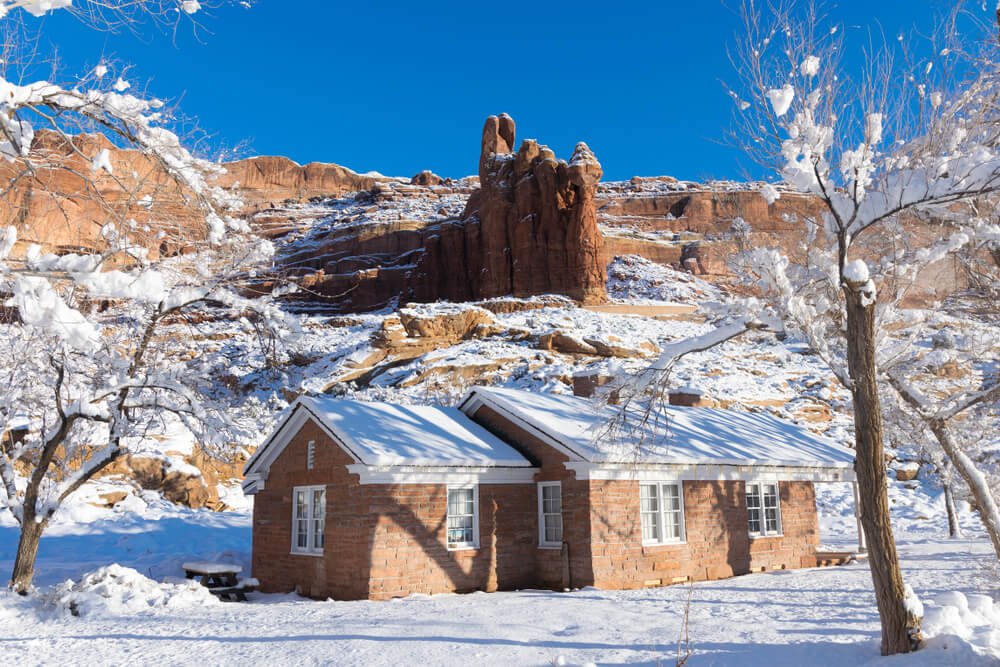
Arches Scenic Road
The Arches Scenic Road is the main paved road through the park.
From this main road, visitors can access the most popular attractions in the park, such as Balanced Rock, Devils Garden, Double Arch, and more! As the main access route in the park, the Arches Scenic Road remains open year-round.
Closures can occur on the Arches Scenic Road for snow removal operations. Call or visit the Arches Visitor Center for a current road conditions report.
Be sure your vehicle is suited to travel the potentially icy roads following winter weather.
Salt Valley Road
In warm season’s dry conditions, the Salt Valley Road, which connects Arches National Park’s main paved road to the Klondike Bluffs and Tower Arch Trailhead, is a two-wheel-drive road fit for most vehicles.
Although come wet or snowy conditions often seen in the off-season, the road can become impassable even with four-wheel-drive capabilities.
This road is not well-marked and is entirely unpaved.
The 10-mile stretch connecting the Devils Garden area of Arches National Park to Highway 191 outside of the park makes a great alternative entrance or scenic detour during promising weather.
The road also offers a faster and more direct exit from the park toward the amenities of town.
Emily is a freelance travel and outdoor recreation writer from Big Sky, Montana. Her adventurous spirit has led her to the high peaks of the Sierras and the largest wilderness areas in the lower 48. When she’s not writing, Emily can be found backpacking, road tripping to outdoor destinations, climbing, or rowing whitewater.